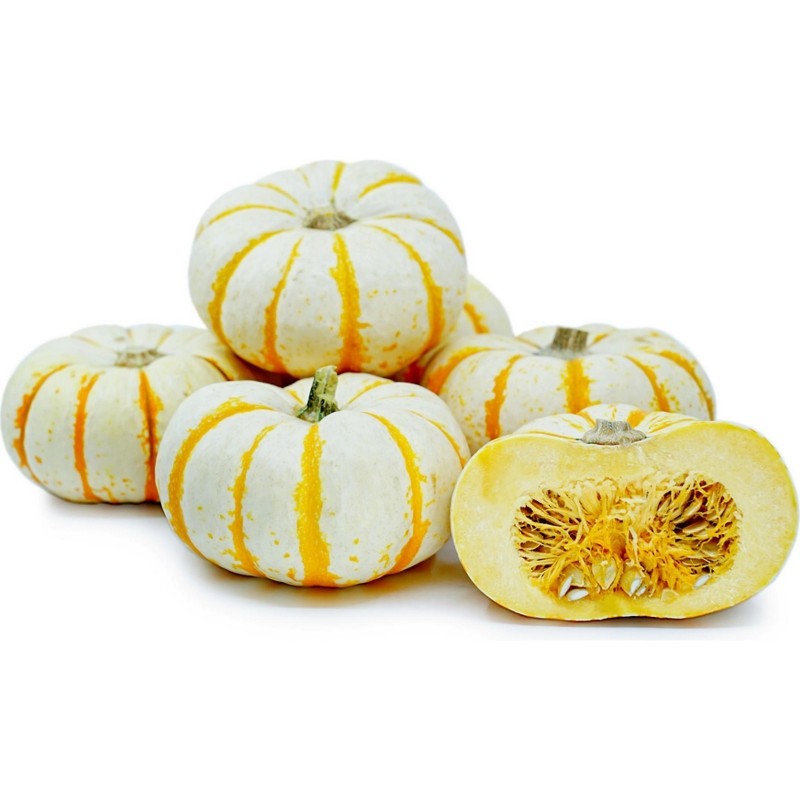- -15%







This traditional ornament of the autumn harvest is good for much more than jack-o-lanterns and pies. High in fiber and essential minerals, their colorful orange flesh signifies an
This traditional ornament of the autumn harvest is good for much more than jack-o-lanterns and pies. High in fiber and essential minerals, their colorful orange flesh signifies an abundance of the antioxidant beta-carotene.
C. pepo 100 days. We are enamored by these delightful, dwarf pumpkins. The adorable, cheery fruit sport bone white rinds adorned with vivid orange in the grooves with a little green thrown in. Rambling plants set excellent yields of the uniform 5 1/2 inch wide by 3 inch high, squat fruit. Lil' Pump-ke-mon brings its vibrant personality to your autumn decorations and fall feasts. Perfectly sized for individual servings filled with steaming, spicy pumpkin soup, or stuffed and baked. And what an enticing presentation!
On average, they will be 4 1/2 inches wide (11 cm) by 2 1/2 inches (6 cm) tall, and weigh 1 to 2 pounds (450 to 900g.)
CULTURE: Pumpkins have the same cultural needs as other members of the squash family. Starting transplants indoors can give you earlier yields and prize winning pumpkins. Start transplants 3 weeks prior to your usual last frost. Use 3-inch Peat or Cow pots and grow with lots of light in a warm area. After they are up and growing well, move them to an outside cold frame. Hardening off for about a week makes a difference in their vigor after transplanting. Once the danger of frost has passed, plant the entire Peat or Cow pot, covering completely. Plant the bush or short-vine varieties in rows 6-8 feet apart with the plants spaced 3-4 feet apart in the row. Large-fruited varieties should be planted in rows 8-10 feet apart, with the plants spaced 4-5 feet apart in the row. Pumpkins and gourds require moderate-to-high levels of fertility. One-half cup of our complete fertilizer should be worked in around the plant when transplanting and another at the 4-6 leaf stage. Soil testing and liming to adjust pH can increase your success. Pumpkins and gourds require uniform irrigation totaling 15-20 inches of water during the growing season. Bee attractant flowers or beehives will help yields. Misshapen or non-developing fruit is often the result of poor pollination.
DIRECT SOWING: Plant after your last frost and when the soil has warmed to at least 60°F. Sow with 3-4 feet between bush varieties, and 4-5 feet between vining varieties. Distance between rows: 6-10 feet. Pumpkins need just-barely-damp soils to germinate. Too much moisture causes the seed to rot. All pumpkins are monoecious (bearing separate male and female flowers on the same plant), and require bee and insect activity for successful pollination. Poor fruit set is often the result of poor pollination.
DISEASES: Pumpkins and gourds are susceptible to many of the common vine diseases, such as wilts, leaf spots and mildews, as well as several viral diseases. Common control measures include crop rotation, field sanitation, and fungicide applications. Consult your local county extension agent with specific problems.
INSECTS: Cucumber beetles and squash bugs can cause problems in squash plants. We've seen striped cucumber beetles turn healthy leaves into something that resembles a nylon sack in a matter of days. Dedicated use of Pyrethrin will help control the problem. Crop rotation can minimize problems with insects.
HARVEST: Exposure in the field to prolonged (1-2 weeks) temperatures below 50°F can result in chilling injury and lead to pumpkins and gourds rotting in storage. Pumpkins can be harvested after their rinds are hard and their skins have turned orange. Leave 3-4 inches of stem on the fruit since pumpkins without stems store poorly. Gourds should be allowed to mature as long as possible on the vine. To dry gourds, first wash gently in a solution of 10 parts water and 1 part bleach, carefully removing all dirt, then store in a warm, dry location. Pumpkins and gourds should be stored at 55-70°F and at 70% relative humidity.
SEED SPECS: Minimum germination standard: 75%. Usual seed life: 3 years.
KEY TO PUMPKIN DISEASE RESISTANCE AND TOLERANCE
HR indicates high resistance.
IR indicates intermediate resistance.
PM | Powdery Mildew
Data sheet

 Reviews (0)
Reviews (0)